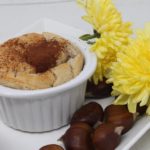SAVOURY PIE WITH LEEKS, SQUASH AND CHESTNUT

A gorgeous pie that increases the freshness of local and seasonal products like squash, leeks and chestnut with a twist given by Phyllo pastry.
Not a personal creation, but a recipe I stole from Cristina Lunardini, an excellent Italian chef, a Romagnolo like me, who I admire, a model to me.
Fresh vegetables which can brighten up our Thanksgiving table or a rainy Sunday brunch; leeks, chestnuts and squash are offered in a new combination, a quite intriguing pie. With this dosage you can make two, you can serve them still warm from the oven or cook and freeze.
Prep Time: 30 minutes | Cooking Time: 50-60 minutes | Total Time: 90 minutes | Yield: Makes 12 servings.
Ingredients:
- 10 sheets of Phyllo pastry, thawed if frozen
- ¼ cup (35 g) corn starch
- 2¼ cups olive oil or unsalted butter, melted if you cannot find good quality olive oil
Ingredients for the filling
- 3 tablespoons olive oil
- 2 leeks, cleaned and cut into rings
- 0,65 pounds (300 g) butternut squash, peeled, seeded, and grated (using the biggest side of a four-sided grater) or finely chopped
- 7 oz (200 g) chestnuts, boiled and peeled
- 7 oz (200 g) creamy cheese (possibly chèvre) or Robiola cheese
- ½ cup (125 ml) milk
- 2 eggs
- 2 oz (60 g) grated cheese
- Sea salt and white pepper, freshly milled
Special equipment
2 plum-cake molds
Instructions
In a pan, brown slightly the leeks and add the squash as they turn into light gold (no more then 10 minutes, as all ingredients will be properly cooked in the oven)
Preheat the oven to 350°F (180 C).
Butter or oil a plum-cake mould.
In a bowl beat eggs with grated cheese, the creamy one and milk. Add salt and pepper and crumbled chestnuts.
Unfold the sheets of phyllo dough, lay the stack on a work surface, and cover with wax paper and then a damp kitchen towel to keep it from drying out. Remove 1 piece of phyllo, place it in the mold, and brush it with some oil (or butter). Continue in the same way with the phyllo and oil/butter until you have used the other 4 sheets of phyllo. Repeat with the other mold.
Move the filling from the pan to the bowl and fill the pies. Cover the tops with the flaps of the phyllo dough, intersecting them and making a kind of decorative pattern. Brush again with some fats.
Bake for 30-40 minutes.
Still excellent if served the day after, warm.

